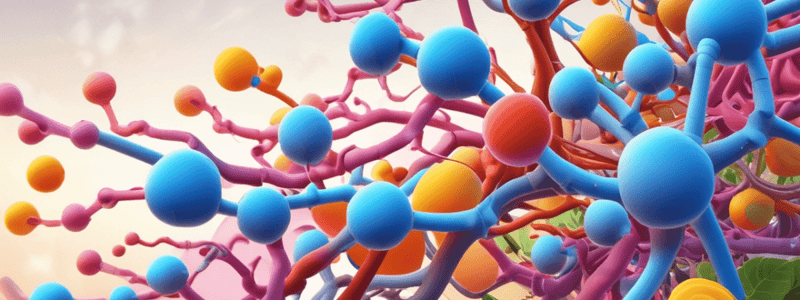Podcast
Questions and Answers
What is the role of UDP-galactose 4-epimerase in the metabolism of galactose?
What is the role of UDP-galactose 4-epimerase in the metabolism of galactose?
- It is responsible for the production of UDP-galactose from UDPglucose
- It catalyzes the conversion of galactose 1-phosphate to glucose 1-phosphate
- It converts UDP-galactose to UDP-glucose by inverting the hydroxyl group at carbon 4 (correct)
- It regulates the activity of galactose 1-phosphate uridyl transferase
Which enzyme catalyzes the conversion of glucose 1-phosphate to glucose 6-phosphate in glycolysis?
Which enzyme catalyzes the conversion of glucose 1-phosphate to glucose 6-phosphate in glycolysis?
- Phosphoglucomutase (correct)
- Pyruvate kinase
- Hexokinase
- Phosphofructokinase
Which of the following is a key regulatory enzyme in the control of glycolysis?
Which of the following is a key regulatory enzyme in the control of glycolysis?
- Glucose 6-phosphatase
- Phosphofructokinase (correct)
- Fructose 1,6-bisphosphatase
- Glucokinase
How is the activity of phosphofructokinase regulated in muscle tissue?
How is the activity of phosphofructokinase regulated in muscle tissue?
What is the role of glucokinase in the liver's glucose metabolism?
What is the role of glucokinase in the liver's glucose metabolism?
How does the liver regulate the balance between glycolysis and gluconeogenesis?
How does the liver regulate the balance between glycolysis and gluconeogenesis?
What is the primary role of gluconeogenesis in the body?
What is the primary role of gluconeogenesis in the body?
What is the role of phosphofructokinase in the liver's glucose metabolism?
What is the role of phosphofructokinase in the liver's glucose metabolism?
How does the regulation of enzymes like pyruvate kinase and hexokinase contribute to the control of glycolysis?
How does the regulation of enzymes like pyruvate kinase and hexokinase contribute to the control of glycolysis?
What is the primary function of glucose 6-phosphate in the body?
What is the primary function of glucose 6-phosphate in the body?
What is the primary purpose of glycolysis?
What is the primary purpose of glycolysis?
Where does glycolysis occur in eukaryotic cells?
Where does glycolysis occur in eukaryotic cells?
How many ATP molecules are produced and consumed during glycolysis?
How many ATP molecules are produced and consumed during glycolysis?
What is the purpose of substrate channeling in glycolysis?
What is the purpose of substrate channeling in glycolysis?
Which of the following is NOT a step in the trapping and preparation phase (Stage 1) of glycolysis?
Which of the following is NOT a step in the trapping and preparation phase (Stage 1) of glycolysis?
What is the primary function of the initial phosphorylation step in glycolysis?
What is the primary function of the initial phosphorylation step in glycolysis?
Which enzyme catalyzes the first step of glycolysis, the phosphorylation of glucose?
Which enzyme catalyzes the first step of glycolysis, the phosphorylation of glucose?
What is the end product of the trapping and preparation phase (Stage 1) of glycolysis?
What is the end product of the trapping and preparation phase (Stage 1) of glycolysis?
Which of the following statements about glycolysis is NOT true?
Which of the following statements about glycolysis is NOT true?
What is the purpose of the isomerization step in the trapping and preparation phase (Stage 1) of glycolysis?
What is the purpose of the isomerization step in the trapping and preparation phase (Stage 1) of glycolysis?
What is the role of phosphoglucose isomerase in glycolysis?
What is the role of phosphoglucose isomerase in glycolysis?
Which enzyme catalyzes the irreversible reaction that is the key regulatory step of glycolysis?
Which enzyme catalyzes the irreversible reaction that is the key regulatory step of glycolysis?
What are the two triose phosphate isomers produced during the first stage of glycolysis?
What are the two triose phosphate isomers produced during the first stage of glycolysis?
Which enzyme catalyzes the oxidation-reduction reaction that converts glyceraldehyde 3-phosphate to 1,3-bisphosphoglycerate during the second stage of glycolysis?
Which enzyme catalyzes the oxidation-reduction reaction that converts glyceraldehyde 3-phosphate to 1,3-bisphosphoglycerate during the second stage of glycolysis?
How many ATP molecules are produced per glucose molecule during glycolysis?
How many ATP molecules are produced per glucose molecule during glycolysis?
What is the net reaction of the conversion of glucose to pyruvate during glycolysis?
What is the net reaction of the conversion of glucose to pyruvate during glycolysis?
Which process regenerates NAD+ from NADH to allow glycolysis to continue?
Which process regenerates NAD+ from NADH to allow glycolysis to continue?
What is the role of fructokinase in the metabolism of fructose?
What is the role of fructokinase in the metabolism of fructose?
Which enzyme catalyzes the conversion of galactose to galactose 1-phosphate in the galactose-glucose interconversion pathway?
Which enzyme catalyzes the conversion of galactose to galactose 1-phosphate in the galactose-glucose interconversion pathway?
What is the role of enolase in glycolysis?
What is the role of enolase in glycolysis?
Flashcards are hidden until you start studying




